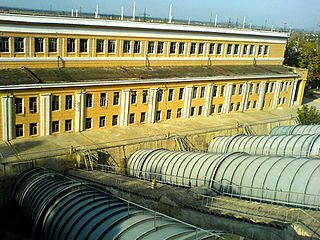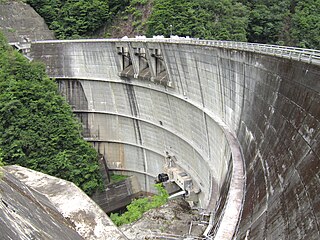
Kárahnjúkar Hydropower Plant, officially called Fljótsdalur Power Station is a hydroelectric power plant in Fljótsdalshérað municipality in eastern Iceland, designed to produce 4,600 gigawatt-hours (17,000 TJ) annually for Alcoa's Fjarðaál aluminum smelter 75 kilometres (47 mi) to the east in Reyðarfjörður. With the installed capacity of 690 megawatts (930,000 hp), the plant is the largest power plant in Iceland. The project, named after the nearby Kárahnjúkar mountains, involves damming the rivers Jökulsá á Dal and Jökulsá í Fljótsdal with five dams, creating three reservoirs. Water from the reservoirs is diverted through 73 kilometres (45 mi) of underground water tunnels and down a 420-metre (1,380 ft) vertical penstock towards a single underground power station. The smelter became fully operational in 2008 and the hydropower project was completed in 2009.

The Robert-Bourassa generating station, formerly known as La Grande-2 (LG-2), is a hydroelectric power station on the La Grande River that is part of Hydro-Québec's James Bay Project in Canada. The station can generate 5,616 MW and its 16 units were gradually commissioned between 1979 and 1981. Annual generation is in the vicinity of 26500 GWh.

The Haditha Dam or Qadisiya Dam is an earth-fill dam on the Euphrates, north of Haditha (Iraq), creating Lake Qadisiyah. The dam is just over 9 kilometres (5.6 mi) long and 57 metres (187 ft) high. The purpose of the dam is to generate hydroelectricity, regulate the flow of the Euphrates and provide water for irrigation. It is the second-largest hydroelectric contributor to the power system in Iraq behind the Mosul Dam.
The Hàm Thuận – Đa Mi Hydroelectric Power Complex is a cascade of two hydroelectric power stations in Hàm Thuận Bắc District of the central region of Vietnam. It is operated by Da Nhim – Ham Thuan – Da Mi Hydropower Joint Stock Co., a subsidiary of Vietnam Electricity. The same company also operates the older Đa Nhim Hydroelectric Power Station.

Lake Qaraoun is an artificial lake or reservoir located in the southern region of the Beqaa Valley, Lebanon. It was created near Qaraoun village in 1959 by building a 61 m-high (200 ft) concrete-faced rockfill dam in the middle reaches of the Litani River. The reservoir has been used for hydropower generation, domestic water supply, and for irrigation of 27,500 ha.

The Ponmudi Dam is a concrete gravity dam built across the Panniyar river which is a tributary of Periyar river at Konnathady panchayath of Konnathadi village in Idukki district of Kerala, India. The dam was constructed in 1963 as a part of a hydroelectric project. Construction was led by E.U.Philipose, Superintending Engineer, Kerala State Electricity Board. It has a length of 288.80 metres (947.5 ft). The hydropower component of the dam has an installed capacity of 30 MW with firm power of 17 MW, generating 158 GWh annually. Taluks through which the river flow are Udumbanchola, Devikulam, Kothamangalam, Muvattupuzha, Kunnathunadu, Aluva, Kodungalloor and Paravur.
The Kambar-Ata Dam is a proposed dam on the Naryn River in central Kyrgyzstan. One of six planned to be built on the river, it will become one of the largest dams in the world at approximately 275 metres (902 ft) high and containing about 370 million cubic metres of rock and earth. The Kambar-Ati-1 Hydro Power Plant at the base of the dam will have the capacity to generate around 2,000 megawatts of electricity. The project will be constructed jointly with Russia and possibly Kazakhstan as well.

The Samanala Dam is a dam primarily used for hydroelectric power generation in Sri Lanka. Commissioned in 1992, the Samanalawewa Project is the third-largest hydroelectric scheme in the country, producing 405 GWh of energy annually. It was built with financial support from Japan and the United Kingdom. It is notable for a large leak on its right bank. Power production continues as planned despite the leakage, and the water from the leak now provides two thirds of the water issued by the reservoir for agriculture in downstream areas.

The Farkhad Dam is a hydroelectric and irrigation dam on the Spitamen in Sughd Province, Tajikistan. It is a part of the Naryn-Syr Darya Cascade. The dam is located on the territory of Tajikistan and controlled by Tajikistan, while the Farkhad hydropower station, operated by Uzbekenergo.

The Kannagawa Hydropower Plant (神流川発電所) is an under construction pumped-storage hydroelectric power plant near Minamiaiki in Nagano Prefecture and Ueno in Gunma Prefecture, Japan. The power plant utilizes the Minamiaiki River along with an upper and lower reservoir created by two dams, the upper Minamiaiki Dam and the lower Ueno Dam. The power station in between the two dams will contain six 470 megawatts (630,000 hp) pump-generators for a total installed capacity of 2,820 megawatts (3,780,000 hp). Unit 1 commenced commercial operation in 2005 and Unit 2 in 2012. When completed, the plant will have the third-largest pumped-storage power capacity in the world.
The Baishan Dam is an arch-gravity dam on the Second Songhua River near the town of Baishanzhen, Huadian, Jilin Province, China. The purpose of the dam is hydroelectric power generation and flood control. The dam supplies water to five turbine-generators in two different powerhouses for an installed capacity of 1,500 megawatts (2,000,000 hp) while it can also control a design 19,100 cubic metres per second (670,000 cu ft/s) flood. Additionally, it has a 300 megawatts (400,000 hp) pumped-storage hydroelectric generation capacity. It is named after Baekdu Mountain, near the city of Baishan.

The Chirkey Dam is an arch dam on the Sulak River in Dagestan, Russia. The main purpose of the dam is hydroelectric power production, and it supports a 1,000 MW power station. Construction on the dam began in 1964, the first generator was operational by 1974, the last in 1976 while the project was officially completed in 1978. It is the tallest arch dam in Russia.
Qorlortorsuaq Dam is a hydroelectric dam near Qorlortorsuaq in the Nanortalik district of the Kujalleq municipality in southern Greenland. It has a capacity of 7.6 MW and it generates power for the neighbouring towns of Qaqortoq and Narsaq.

The Ituango Dam, also referred to as the Pescadero-Ituango Dam or Hidroituango, is an embankment dam currently under construction on the Cauca River near Ituango in Antioquia Department, Colombia. The primary purpose of the project is hydroelectric power generation and its power plant will have an installed capacity of 2,456 megawatts (3,294,000 hp) if completed. Preliminary construction on the dam began in September 2011 and the power plant was expected to begin operations in late 2018, but will not after heavy rainfall and landslides in April/May 2018 blocked the river's diversion tunnel, threatening a breach of the dam. If completed, it will be the largest power station in Colombia.

The Okuyoshino Pumped Storage Power Station (奥吉野発電所) is located 15 kilometres (9.3 mi) north of Totsukawa in Nara Prefecture, Japan. Using the pumped-storage hydroelectric method, the power plant has an installed capacity of 1,206 megawatts (1,617,000 hp). To accomplish power generation, the power station shifts water between two reservoirs, the lower Asahi Reservoir and the upper Seto Reservoir. Construction on both the Asahi and Seto Dams began in 1971 and was complete in 1978. The power station was commissioned in 1980. Due to heavy sediment and turbidity in the Seto Reservoir, caused by logging and landslides upstream, a sediment bypass tunnel was constructed between 1992 and 1998.
The Trung Sơn Dam is a hydroelectric power station on the Ma River in northwestern Vietnam. Located in the Trung Sơn commune, Quan Hóa District, Thanh Hóa Province, it is approximately 95 kilometres (59 mi) southwest of Hòa Bình city, and 195 kilometres (121 mi) northwest of Thanh Hóa city. The dam created a reservoir which covers a large area of the Mường Lát and Quan Hóa Districts in the Thanh Hoa province as well as part of the Mộc Châu District in Sơn La Province. It is approximately 9.5 kilometres (5.9 mi) from the Vietnam–Laos border. The 260 MW associated power plant became fully operational in September 2017.
The Bumbuna Dam is a concrete-face rock-fill dam on the Seli River near Bumbuna in Tonkolili District, Sierra Leone, and 350 kilometres (220 mi) from the capital of Freetown, the main consumer. The country's first hydroelectric dam, it supports a 50-megawatt (67,000 hp) power station.
The Pangduo Hydro Power Station is a reservoir and dam on the Lhasa River in Lhünzhub County to the east of Lhasa, Tibet Autonomous Region, China. The primary purposes are hydroelectric power generation and agricultural irrigation. Work started in 2008. The first turbine came into production in 2013 and the other three turbines in 2014. With annual generation capacity of 599 million kilowatt hours, it has been called the "Tibetan Three Gorges". Nevertheless, the comparison is hyperbole since the dam is only able to impound less than 1/30th that of Three Gorges.(31.9 vs 0.97 million acre-feet).

The Vorotan Cascade, or the ContourGlobal Hydro Cascade, is a cascade on the Vorotan River in Syunik Province, Armenia. It was built to produce hydroelectric power and provide irrigation water. The Vorotan Cascade consists of three hydroelectric power plants and five reservoirs with a combined installed capacity of 404.2 MW. It is one of the main power generation complexes in Armenia.
The Toulnustouc generating station, is a hydroelectric power generating station managed by Hydro-Québec on the Toulnustouc River in the territory of Côte-Nord, Quebec, Canada. It has an installed capacity of 526 MW. The power station is fed by water from a dam and dyke that contain the Lake-Sainte-Anne reservoir.














